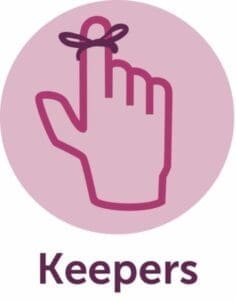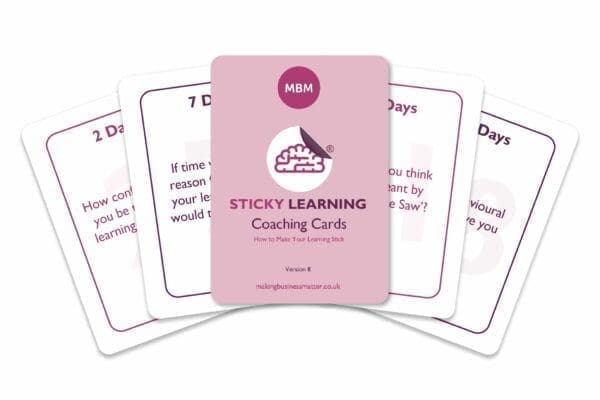It’s as Easy as 1,2,3…
In this article, I would like to share with you several Accelerated Learning Tools that will help you learn more, faster, and retain more’. In our busy schedules, you don’t have the time to waste spending one day on a training course without getting the very most from that day.
There are many Accelerated Learning Techniques. I will share those learning techniques that worked for me and the many people that I have trained and coached. Some tools are a ‘quick grab’, others will need further work on your part. Some you could probably choose to park until you have locked away one or two.
#1 of the Learning Tools
What Day-to-Day Problems Do You Want to Solve?
You might say that this is obvious and I would agree, yet so many people have not put any thought into what they want to get from the time they are investing in being trained. Be specific. For example, if you taking part in Time Management Training, your thinking needs to have progressed beyond the objective of ‘improve my time management’. Because to have saved 1 minute in the next 12 months would have achieved your objective, yet you have spent 8 hours being trained. Therefore the equation is in deficit and at the very minimum if you are spending 8 hours being trained then you want that amount of time back in the next 3 months.

Take 20 minutes to write down the top 3 day-to-day problems that you have with your time management. For examples; ‘My inbox is out of control with over 250 emails per day I spend forever in my inbox’, or ‘At least once per week I’d like to go home on time’, or ‘Our meetings always run over, have no agenda, and no real purpose’. These are your real day-to-day problems. They are your reasons to invest your time being trained so that you get the solutions that you need.
#2 of the Learning Tools
Sticky Learning ® is 7 times more effective than 1-day training courses. Plus, you will get a Chain of Evidence proving your Return on Investment. Discover soft skills training that changes behaviours long term.

“The Best Way to Ride a Horse is the Way That it is Going!”

You may have heard about ‘Learning Styles’ and such terms as ‘Reflector, Activist, Pragmatist and Theorist’. These are labels given to the way that people prefer to learn. Knowing your individual learning style will take a little effort. Then you will find that by understanding your learning style you’ll better understand why it is that when you are learning you prefer to ‘get up and have a go’, or ‘sit back and have a think’, and so on.
Let’s start by understanding your learning style. My preferred company for doing this is Honey and Mumford because I regard these guys as the most accurate. We use their 80 question questionnaire in our training which costs £25 from Honey and Mumford. The 40 question questionnaire is sufficient to begin with and is available as a pdf to download. Write your answers on to know which is your preferred learning style.
Once you have identified your learning style you’ll feel more comfortable in learning situations. For example saying, ‘I’m a Reflector, therefore I don’t want to get up and have a go’. Or equally, ‘As an Activist, I really need to be engaged with this actively, otherwise, I get bored very quickly’.
#3 of the Learning Tools
Throw the Deck Away Because You’ll Never Look at it Again
How many people have attended a great training day, and received a deck of slides? Then left the day with renewed enthusiasm to be a better manager, salesperson, team player, etc. Only to have found the slides a year later in an office ‘tidy-up’, to then throw them out? Most people, including myself, have committed this crime. A crime because I invested 1 day from my busy schedule into training, only to find that I had put on hold most of my learning for ‘When I get to those slides and review them, I’ll be awesome’ – Only for it to never happen.
There is a better way, ‘Keepers’. Keepers is all about taking away the golden nuggets that resonated with you because your golden nuggets will be a different group of golden nuggets to the guy next to you. His golden nuggets different to the guy next to him. As you begin your training take a page in your book, or a new piece of paper, and write ‘Keepers’ at the top, plus the training, e.g.’ Time Management’, and the date. Then make 3 columns and split the page into 10 rows covering the entire page. As you progress through your training capture any significant piece of learning that resonates with you, for example ‘Learning styles’.
How to Use Keepers
In the first column headed ‘Nugget’ write ‘Learning Styles’ and a few bullet points that you wish to remember. Draw a piece about learning styles, in the second column headed ‘Image’, that helps you remember what learning styles are about. In the third column headed ‘Action’ write what you are going to do next with that golden nugget of ‘Learning styles’, e.g. Identify my learning style.
When you leave your training you will have one or two pages of golden nuggets or ‘Keepers’. These have resonated with you, were captured by you. So they have meaning and you can easily refer back to one or two pages very quickly to recollect the training, rather than a deck of slides.
To receive a copy of the Keepers template please contact us.

#4 of the Learning Tools
Mind-maps Work in the Way That the Brain Likes to Remember
Most people have heard of mind mapping. Yet few use the potential of mind mapping to improve their performance at work. Mind maps are a powerful tool for freeing your brain. Imagine you have a big project starting soon. The downside of using lists is that the brain tries to do two things; write a list of items and secondly try to put them in order. The brain struggles to do both well at the same time.
Mind mapping enables your brain to write down whatever it wants about the project. And that is without being hamstrung by having to also have put it in order. Mind maps are an alternative to a Keepers form. Either tool, keepers or mind maps, is very effective for capturing learnings. Tony Buzan, the creator of Mind mapping explains how to mind map in this 5-minute video below:

#5 of the Learning Tools
Radio Wii-FM
Radio Wii-FM is about ‘What’s in it for me?’. We’ve all been to training courses and almost ‘rocked-up and expected the trainer to entertain us’. To get more from our training we need it to matter and in order for the training to matter, we need to identify why we are there. In essence, what’s in it for me? If we can make the learnings matter to us because they either solve a problem for us, or help us do something better, we’ll engage more, question more, listen more and retain the learnings more, and for longer.
In our unique Sticky Learning ® method we use an ‘Individual Learning Objective’ – To access an exclusive ‘Individual Learning Objective’ webpage please contact us.

>> Sticky Learning Coaching Cards <<
>> Buy on Amazon <<
>> Buy on Etsy <<
#6 of the Learning Tools
We Forget 80% Within 30 Days
According to the founder of the ‘Forgetting Curve,’ we forget 80% of what we have learnt within 30 days. Herrmann Ebbinghaus, a German psychologist, discovered in the mid 1800s that we forget over time. Today this research is not surprising, but the amount we forget and how quickly is. Ebbinghaus said that we forget huge amounts of what we have learnt quickly unless we can help ourselves to remember.
‘Spaced repetition‘ is one of the ways that will help us remember more. Simply, it is about reviewing your keepers or mind maps frequently. Once per month, until the learnings are locked-in and used.

In our unique ‘Sticky Learning ®‘ method we use ‘Sticky Pieces’ timed at the appropriate moment that the memory drops occur to help learners to retain more of their learnings by doing appropriate activities – To access an exclusive page that shows how Sticky Pieces work please contact us.
#7 of the Learning Tools
Forming habits helps us remember
BJ Fogg, a professor at Stanford University, and the modern father of understanding habits tells us that forming habits is dependent on your ability and your motivation. Using this graph below will help a learner to identify where they are with a particular habit they are trying to form. It can also help you understand why the habit is failing and how you can help form the habit more easily. One of the habits we encourage learners to form from our Time Management Training is to write a to do list daily. Knowing where the learner sits on this graph and knowing that a task needs to be repeated 21 times in a month to become a habit helps them understand the challenge.

In our unique Sticky Learning ® method learners engage in a ‘Learning to Learn’ training course before they begin learning with us because most learners do not know how to retain their learnings.
Finally, #8th of the Learning Tools
Am I Going Mad? Talking to Myself
‘Spaced Repetition’ is one of the ‘7 Ways to Retain Learnings Longer from Your Training’, as you have read above.
To build further on reliving, re-learning, and reviewing your mind maps or keepers, is to understand that there is a useful model that will help you to achieve sustainable learning. This is ‘VKA’; ‘Visual’, ‘Kinesthetic’ and ‘Auditory’. Simply put, these are the three ways that we receive input. Therefore by re-writing your mind maps/keepers each month and reading aloud the notes, as you write, you will appeal to all 3 forms of input. Visual – You’ll see the notes being written, Kinesthetic (from the Greek ‘kinein’ – to move), you’ll feel the pen moving as you write and Auditory – You’ll hear yourself speak the words.
To see all the tools in our toolbox that enable learners to retain learnings longer from their training, please contact us.
The Next 24 Hours Are Critical
Stephen Covey, the author of ‘7 Habits of Highly Effective People‘, teaches us that the first 24 hours after you learn something new is critical. One of the fastest ways to lock in your new learnings is to teach someone else. This works because the act of teaching someone else what we have learnt forces us to have digested the learnings, understood the learnings and then put the learnings in our own words and be ready for questions. By doing this act we re-live the learnings over and over because we all want to look competent when we teach someone else.
Science Shows Accelerated Learning Works

Indeed, science supports accelerated learning.
In 2014, the Journal of the Association for Psychological Science published a Princeton University study that challenged the long-held view that deliberate practice (or learning) for an extended time is the best way to master a skill. “We found that deliberate practice explained 26% of the variance in performance for games, 21% for music, 18% for sports, 4% for education, and less than 1% for professions”, reads the study’s summary.
The researchers in the study concluded that “deliberate practice is important, but not as important as has been argued.”
Tips to Make Accelerated Learning Work
Here are 14 ways you can make accelerated learning work for your team:
#1 – Define and Write Goals
Ask them to write definitive goals showing what they to achieve. They must be SMART goals; Specific, Measurable, Achievable, Realistic and Timely. Vague goals will lead to procrastination and no change in behaviour. Putting clear objectives on paper helps them to select soft skills that are relevant to them and the business so that together they can increase performance for both the individual and the business. For example, ‘to be a better time manager’ is not a SMART learning objective. ‘To write a daily to do list’ is a SMART time management learning objective.
#2 – Ask Each Learner to Identify What’s In It For Them
When each member of your team knows what they stand to gain, their accelerated learning process is enhanced. Benefits always motivate and make things look easier. This is where a Learning to Learn training course is helpful. This is a training course that equips Learners with how they can learn faster by understanding memory retention, habit formation, and much more.
#3 – Customise the Training for Their Needs
All training is not the same. To succeed in accelerated learning, tailor the training course to the unique needs of your team. In fact, if you give the team a one-size-fits-all training, you are inviting failure. Challenge the trainer to understand the challenges your team face on a day-to-day basis, looking for the behaviours that you need changing and the different results that you and they need.
#4 – Remove Emotional Barriers to Accelerated Learning
Physical barriers like noisy environments are significant obstacles to any form of learning. However, often the barriers that derail accelerated learning the most are emotional.
For example, staff members might be scared of failure or not embrace it as part of the process of learning. Bring this to their attention and cultivate self-confidence as well as tailor the criticism of their progress into a positive one. This will help them to overcome self-doubt and thus engage more.
#5 – Accelerated Learning Requires Oxygen and Water
At the training venue, water and oxygen are two things you need to make the brains of the Learners to function efficiently. Dehydration hampers concentration, and the same goes for a poor or low supply of oxygen.
Ensure that water is never in short supply and the venue has good ventilation. To further increase the absorption of oxygen to the brain, encourage the Learners to stand up and move about at least once every hour. Sitting continually for more than an hour can reduce the oxygen supply to the brain by about 15%. Plus, remove sweets, and offer healthy slow-release energy snacks like popcorn.
#6 – Capture the Imagination of the Learners
The imagination of the Learners is an important tool for accelerated learning. One way to capture a Learner’s imagination is to provide the big picture first before the nitty gritty. The outline of the course, as well as the goals and objectives, can serve this purpose, or to get them to verbalise, or draw the benefits of being on the training.
Fail to provide the picture and the Learners won’t be seeing the path you want them to walk with you. They will waste a lot of time struggling to make sense of everything.
#7 – Acknowledge Short Attention Spans
The concentration span of most of us isn’t more than 20 minutes. If the same activity drags out for more than that, we are highly likely to lose interest. But how can you guard against the loss of interest in your course material?
Let Learners do tasks in intervals of about 10 minutes. Also try and break ideas into smaller manageable bits, with breaks between them. A Distraction List can help too.
#8 – Music Too Can Help Accelerated Learning
Yes, music in the background can contribute to accelerated learning. This is straight from Dr. Georgi Lozanov, the father of accelerated learning. And in support of Dr. Lozanov’s assertion is a theory known as ‘the Mozart Effect,’ which has shown that music in the background calms learners and helps them concentrate.
Aside from creating the right atmosphere for doing learning activities, such as attempting quizzes, music also improves brain performance and even boosts IQ. Baroque music is thought to be the most appropriate because of the number of cycles in the music,
#9 – Encourage Practice with New Skills
We learn well by both theory and practice. Your team should take immediate and repeated action with what they learn so that it properly sticks. Immediate application of acquired skills ensures that gaps are sealed early enough. It is important to learn the same skill in more than one way. For example, the trainees can have a theory session followed by a practical one.
#10 – Let Trainees Coach Each Other
Being taught is the standard way of learning. However, taking up the challenge to teach others what we’ve learned helps even more. It makes new skills stick. It is, therefore, a good idea for the trainees to take turns training each other on what they learn from their accelerated learning course- Team Building Skills.
#11 – Asking Questions is a Critical Component
Asking questions is a component of accelerated learning that your Learners can’t do without it. And this should be made clear from the word go. Questions help fill knowledge gaps that might be ignored by the facilitator.
Even more, asking questions removes doubts, clears misinterpretations and increases concentration. It also encourages the active participation of everyone. And that is a good thing.
#12 – Measure Progress
It doesn’t make sense to have your team attend a training course whose impact can’t be measured. It is important to know whether an accelerated learning program is giving you value for money.
Do routine tests as your team goes along with the learning. Make sure those tests don’t turn into obstacles, though, especially as pressure on the trainees. Measure your return on investment.
#13 – Test Themselves
A research scientist called Roddy Roediger conducted an experiment on memory retention. His conclusion was that those groups that were tested on what they had learnt were able to recall twice as much. So getting the Learners to test each other is a powerful tool to accelerate learning.
#14 – Mnemonics are Very Powerful
Taken from ’14 compelling reasons why Sticky Learning ® works and the science behind it’. Each of our trainers understands the importance of what cognitive researchers call ‘encoding’. Encoding happens when the Learner can relate a new piece of information to existing knowledge. A little like Christmas baubles. To add new information (baubles) you need to build it on existing knowledge/experience (Tree).
Use these Accelerated Learning tips and you will improve the speed at which your team learn and embed their new skills.




